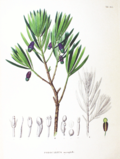Podocarpus macrophyllus
Species of conifer in the family Podocarpaceae From Wikipedia, the free encyclopedia
Podocarpus macrophyllus is a conifer in the genus Podocarpus, family Podocarpaceae. It is the northernmost species of the genus, native to southern Japan and southern and eastern China. Common names in English include yew plum pine,[3] Buddhist pine, fern pine and Japanese yew.[4] Kusamaki (クサマキ) and inumaki (犬槇) are Japanese names for this tree. In China, it is known as luóhàn sōng (羅漢松), which literally means "arhat pine".
| Podocarpus macrophyllus | |
|---|---|
 | |
| Scientific classification | |
| Kingdom: | Plantae |
| Clade: | Tracheophytes |
| Clade: | Gymnospermae |
| Division: | Pinophyta |
| Class: | Pinopsida |
| Order: | Araucariales |
| Family: | Podocarpaceae |
| Genus: | Podocarpus |
| Species: | P. macrophyllus |
| Binomial name | |
| Podocarpus macrophyllus (Thunb.) Sweet | |
| Varieties[2] | |
| |
| Synonyms[2] | |
| |
Description

It is a small to medium-sized evergreen tree, reaching 20 m (66 ft) tall.[5] The leaves are strap-shaped, 6–12 cm (2.4–4.7 in) long, and about 1 cm broad, with a central midrib. The cones are borne on a short stem, and have two to four scales, usually only one (sometimes two) fertile, each fertile scale bearing a single apical seed 10–15 mm. When mature, the scales swell up and become reddish purple, fleshy, and berry-like, 10–20 mm long; they are then eaten by birds, which disperse the seeds in their droppings.
P. macrophyllus occurs in forests, open thickets, and roadsides from near sea level to 1000 m above it.[5]
Varieties
Two varieties are accepted.[2]
- Podocarpus macrophyllus var. macrophyllus – southern China, southern Taiwan, and Japan (Honshu and Shikoku)
- Podocarpus macrophyllus var. maki Siebold & Zucc. (synonym P. chinensis Wall. ex Benn.) – southern China, northern Myanmar, Taiwan, and south-central and southern Japan
Symbolism, cultivation, and uses
Kusamaki is the state tree of Chiba Prefecture, Japan. It is a popular large shrub or small tree in gardens, particularly in Japan and the Southeastern United States. The ripe cone arils are edible, though the seed should not be eaten. Because of its resistance to termites and water, inumaki is used for quality wooden houses in Okinawa Prefecture, Japan.
Buddhist pine is highly regarded as a feng shui tree in Hong Kong, giving it a very high market value. In recent years, the illegal digging of Buddhist pine has become a problem in the city.[6]
Gallery
- From Flora Japonica by Philipp Franz von Siebold and Joseph Gerhard Zuccarini.
- A closeup of the leaves.
- Foliage with mature seed cones.
- A trimmed P. macrophyllus.
References
External links
Wikiwand - on
Seamless Wikipedia browsing. On steroids.





